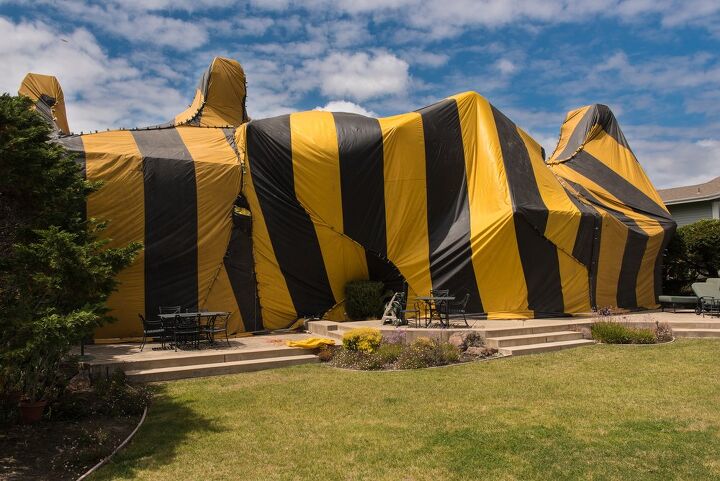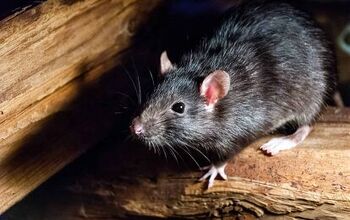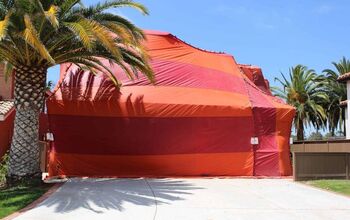Does Termite Fumigation Kill Rats? (Find Out Now!)

Termite fumigation uses chemicals that penetrate walls to kill unreachable termites, so will termite fumigation kill rats in the walls too? The fumigation process is an effective option, but it can be disruptive to your everyday life as it is lethal for mammals. It requires you to make preparations inside your home and stay out of it for a certain amount of time.
Termite fumigation will kill rats, mice, and any other mammals in your home. If you suspect that you may have a rodent infestation, it’s important to resolve this before termite fumigation. It’s also imperative that you and any pets don’t return to the house until the exterminator clears you to do so.
Do You Need Pest Control Services?
Get free, zero-commitment quotes from pro contractors near you.

What Is Termite Fumigation?
Termite fumigation is a process termite-control professionals use to kill termites. The process occurs when professionals release a gas fumigant into an enclosed area in order to eliminate the insects. This process works best when used against drywood termites, which often embed themselves in furniture or hard-to-access beams, walls, and floorboards.
When a home is fumigated, the gas penetrates the wood structures where termites live. Like oxygen or helium, the fumigant is a true gas, so it won’t leave behind any residue.
Does Termite Fumigation Kill Rats?
When a termite infestation is deep within your home, fumigation may be the best option. However, the fumigant is toxic to people, pets, and plants in addition to termites. It’s important that you take the proper precautions before you fumigate your home.
Termite fumigation is beneficial because it will effectively kill any other bugs that may be living in your home uninvited. However, termite fumigation will also kill any rats, mice, or other mammals in your home. If you suspect that you have a rat problem, it’s important to address that before the fumigation occurs.
Neglecting your rat problem before termite fumigation can leave you with a host of other issues. If you don’t treat rats before the fumigation process, you may not find them until you notice their decaying smell. Plus, if they’re burrowed in a wall or other hard-to-reach area, this can lead to more damage.
Furthermore, if you don’t notice the smell at first, you’ll soon notice when there’s an influx of ants in your home. Ants often enter your home after the fumigation process to feast on the rats. Therefore, to prevent an ant infestation in addition to your termite infestation, it’s best to address your rat problem first.
Alternatives To Ridding Your Home Of Rats
Follow these tips below if you need to rid your home of these rodents before beginning termite fumigation. These tips should solve your rat problem, but you may need to contact a professional if they don’t.
The first step is to seal all possible entry points to your home. Check for any holes near windows, cabinets, closets, or outside doors. Also, check under each sink for holes as well as around appliance pipes.
To keep rats away, cut off their food and water source, they won’t survive and will move elsewhere. Keep all food in sealed containers, don’t leave pet food out overnight, and keep all fruits and vegetables inside the refrigerator. If you have leaky pipes or faucets, fix them immediately and keep all trash and compost receptacles closed.
Using Termite Fumigation
Termite fumigation is required where there is a serious termite infestation. The most common termite associated with termite fumigation is drywall termites. They don’t have to be in contact with moist soil like subterranean termites do, so they can move throughout the home.
Drywall termites can move farther from the ground and eat the wood inside of your walls. Once this happens, structural fumigation is one of the only options to rid your home of them.
Termite fumigation is time-consuming, but it can also be dangerous if you aren’t properly prepared. It’s important to follow all advice of your termite exterminator so that your family, home, and belongings are safe.
Before you begin the termite fumigation process, it’s important to take the following steps.
Step 1: Remove Yourself And Certain Items From Your Home
Once the fumigation process starts, you will not be able to re-enter your home, so prepare to stay somewhere else. Your fumigator will be able to give you a specific time frame for how long to stay out of the home. No one can go back into the home until the fumigator has released it for re-entry.
There are several things you will need to remove from your home before the fumigation process. Fumigants are toxic to pets, fish, reptiles, and house plants, so remove them before the fumigation. You should also remove any opened food items and anything consumable such as medication, pet food, and dental products.
If you are leaving opened food products in the refrigerator or freezer, double bag these items using bags provided by your fumigator. If you have fish tanks with live fish, they must be removed before fumigation. The fumigant can affect the entire aquarium, so consult with your aquarium supplier to safely move your aquarium.
Step 2: Open All Doors
Open all doors between rooms, cabinet doors, closets, appliances, safes, the attic, and the basement. You should also open all cabinets, and dresser and desk drawers. Additionally, raise all blinds and open your window drapes so that the fumigator can easily open the windows.
Step 3: Expose Your Exterior Foundation And Remove Exterior Devices For Proper Tenting
Rake back any gravel or mulch and move any plants to expose your exterior foundation. If necessary, you may need to dig up your landscaping in order to provide room for the tenting.
Remove or lower any devices on your roof or the exterior of your home in order for the tenting to be effective. This includes antennas, weathervanes, chimney stacks, or mechanical awnings.
Step 4: Create Access To Closets, Storage Rooms, And Crawl Spaces
For the fumigation to work best, the fumigant needs to reach every part of your home. Make sure there is clear access to closets, storage rooms, and crawl spaces. This will allow the fumigant to penetrate the hard-to-reach areas of your home.
Step 5: Turn Off Heat Sources And Unplug Appliances
Some fumigants can have a corrosive or other reaction when they are in the presence of a heat source. If your home has natural gas, make sure that your gas company turns it off and locks it out at the meter. This will prevent natural gas buildup inside of the tent in the event there is a leak in the gas lines.
Some fumigators require you to unplug and turn off appliances, computers, and heaters. You may also be required to extinguish pilot lights and have the gas service suspended during the fumigation process.
Do You Need Pest Control Services?
Get free, zero-commitment quotes from pro contractors near you.

Related Questions
What’s the average cost for termite treatment?
The price of your termite treatment will vary depending on several factors. This includes the type of treatment, the extent of the infestation, and if the structure is in a damp or dry area. The average cost of termite treatment ranges from $330 to $815 for chemical treatments or bait stations. Termite fumigation is the most effective and most expensive form of termite control. The process ranges from $1,280 to $3,000 on average, or $1 to $4 per square foot. Another option when tenting your home for termites is heat treatment. This is a natural and non-toxic way to kill termites by heating the area to 150 degrees Fahrenheit. Heat termite treatment ranges from $800 to $2,800, or $1 to $2.50 per square foot.
How long after termite fumigation can I return to my home?
The average time to reenter the home after the fumigation process has finished is 8 hours. However, the fumigation process can take up to 60 hours. The toxicity levels can remain for several days after the fumigation. Professionals advise not allowing children, vulnerable people, or pets to enter the home until 24 to 72 hours after the fumigation.
What are the signs of termite damage?
There are several signs of termite damage, but the most popular are damaged wood, termite mud tubes, and drywall pinholes. Termite damage can appear like a carved maze on wood. Damaged, bumpy, or uneven wood can often look like water damage, but is in fact, termite damage. Pinholes in the drywall are usually a tell-tale sign that termites are present. Outside of your home, you may spot termite mud tubes. These are dark tunnels usually found on the exterior home siding. Another way to determine if there’s termite damage is to tap on the wooden areas of your home with a screwdriver. If the wood makes the same sound throughout, you are okay. However, if you can hear hollow sounds in some places, you may have an infestation.

Stacy Randall is a wife, mother, and freelance writer from NOLA that has always had a love for DIY projects, home organization, and making spaces beautiful. Together with her husband, she has been spending the last several years lovingly renovating her grandparent's former home, making it their own and learning a lot about life along the way.
More by Stacy Randall

















![12 Washing Machine Brands to Avoid [with Recall Data]](https://cdn-fastly.upgradedhome.com/media/2023/07/31/9075781/12-washing-machine-brands-to-avoid-with-recall-data.jpg?size=350x220)









